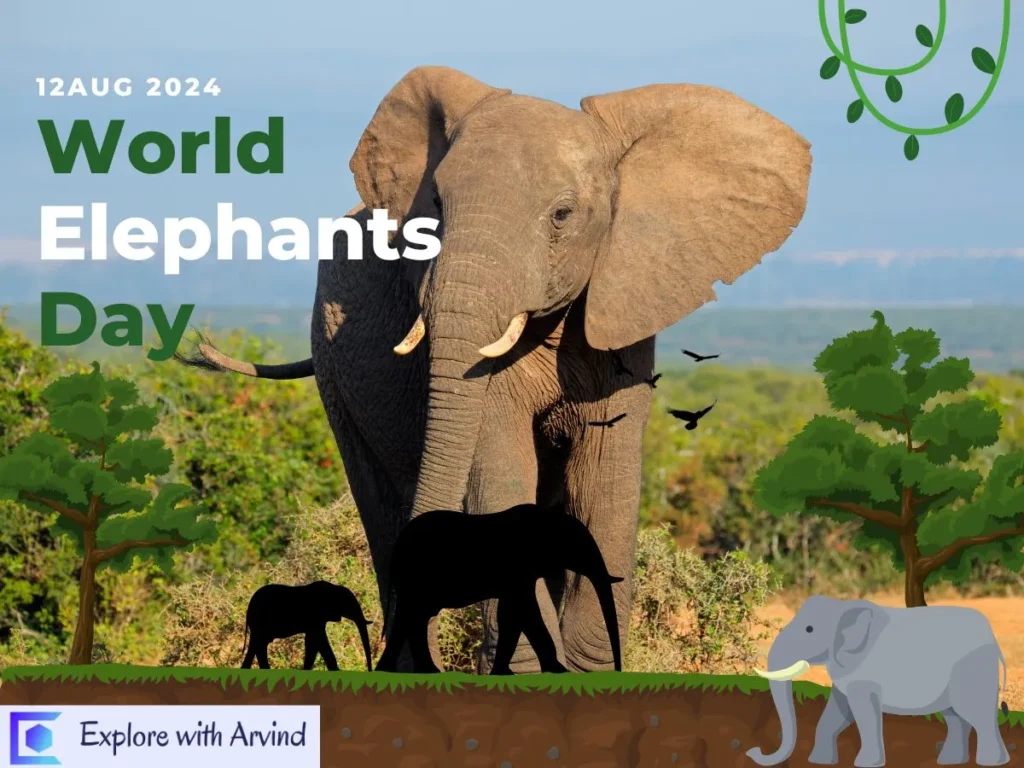Table of Contents
ToggleWorld Elephants Day on 12th August 2024
Every year on August 12th, the world comes together to celebrate World Elephants Day, a day dedicated to the preservation and protection of one of the planet’s most majestic and gentle giants: the elephant. This annual event aims to raise awareness about the urgent plight of elephants in the wild and to promote better protection policies for them. As we delve into the significance of this day, let’s explore the reasons behind its inception, the current state of elephant populations, and how we can contribute to their conservation.

The Origins of World Elephants Day
World Elephants Day was first launched on August 12, 2012, by the Elephant Reintroduction Foundation and Canadian filmmaker Patricia Sims. The goal was to create a platform that brings attention to the numerous threats faced by elephants and to encourage efforts to ensure their survival. Over the years, this day has grown into a global movement, uniting individuals, organizations, and governments in the fight to protect these incredible animals.
The Importance of Elephants in Ecosystems
Elephants play a crucial role in maintaining the biodiversity of the ecosystems they inhabit. As keystone species, they help shape their environment in ways that benefit countless other species. For example, elephants are known to create water holes that are used by other animals during dry seasons. They also disperse seeds through their dung, promoting plant growth and contributing to forest regeneration.
In Africa, savanna elephants help maintain the grassland ecosystem by preventing the overgrowth of trees and shrubs. In Asian forests, elephants contribute to the creation of pathways that facilitate the movement of other wildlife. The loss of elephants would have far-reaching effects on the health and stability of these ecosystems.
Current Challenges Facing Elephants
Despite their ecological importance, elephants are facing numerous threats that have led to a significant decline in their populations. The primary challenges include:
Habitat Loss
As human populations expand, elephant habitats are increasingly being converted for agricultural, industrial, and urban development. This loss of habitat leads to a reduction in the space available for elephants to roam and find food, ultimately resulting in conflicts between humans and elephants.
Poaching and Illegal Wildlife Trade
The illegal ivory trade remains one of the most significant threats to elephant populations, particularly in Africa. Poachers kill elephants for their tusks, which are then sold on the black market. Despite international bans on ivory trade, the demand for ivory products persists, driven by markets in some parts of Asia.
Human-Elephants Conflict
As elephants lose their natural habitats, they often come into closer contact with human communities. This can lead to conflicts, as elephants may raid crops or damage property in their search for food. These encounters can be dangerous for both humans and elephants, sometimes resulting in injury or death.
Climate Change
Climate change is altering the landscapes that elephants depend on. Changes in rainfall patterns can affect the availability of water and food sources, making it harder for elephants to survive. Additionally, extreme weather events such as droughts and floods can have devastating impacts on elephant populations.
Conservation Efforts and Success Stories
Despite the challenges, there are numerous conservation efforts underway that aim to protect elephants and ensure their survival. These initiatives are often led by a combination of governments, non-governmental organizations, and local communities. Some notable examples include:
Anti-Poaching Initiatives
Many organizations are working to combat poaching through increased patrols, the use of technology such as drones, and the training of anti-poaching units. These efforts have led to significant reductions in poaching activities in some areas.
Habitat Protection and Restoration
Conservationists are working to protect and restore elephant habitats by establishing protected areas and wildlife corridors. These corridors allow elephants to move safely between different regions, reducing the risk of human-elephant conflict and ensuring access to vital resources.
Community-Based Conservation
Engaging local communities in conservation efforts is crucial for their success. Community-based conservation programs provide education and resources to help people live alongside elephants without conflict. By involving communities in the decision-making process, these programs foster a sense of ownership and responsibility for elephant conservation.
International Cooperation
Global collaboration is essential to address the transboundary nature of elephant conservation. International treaties such as the Convention on International Trade in Endangered Species of Wild Fauna and Flora (CITES) play a vital role in regulating the trade of ivory and other elephant products. Additionally, cross-border conservation initiatives help protect elephant populations that migrate across national boundaries.
How You Can Help
Everyone has a role to play in elephant conservation, and there are numerous ways to get involved:
Raise Awareness
One of the most effective ways to help elephants is by raising awareness about their plight. Share information about World Elephant Day and the challenges elephants face on social media, in your community, and with your friends and family.
Support Conservation Organizations
Many organizations are dedicated to protecting elephants and their habitats. Consider supporting these groups through donations, volunteering, or participating in their events and campaigns.
Choose Elephant-Friendly Products
Be mindful of the products you purchase. Avoid items made from ivory or other elephant parts, and support companies that are committed to sustainable and ethical practices.
Advocate for Policy Change
Encourage your government to support stronger conservation policies and international agreements that protect elephants. Advocacy can include writing letters to lawmakers, signing petitions, and participating in public demonstrations.
Conclusion
World Elephant Day serves as a powerful reminder of the beauty and importance of elephants, as well as the urgent need to protect them. By coming together and taking action, we can ensure that future generations will continue to marvel at these magnificent creatures. Whether through raising awareness, supporting conservation efforts, or making mindful choices, each of us can contribute to the survival and well-being of elephants. This August 12th, let’s celebrate World Elephant Day with a renewed commitment to preserving these gentle giants and the ecosystems they call home.